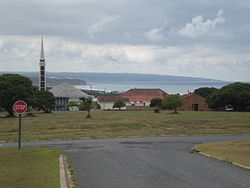Stilbaai | |
|---|---|
 Stilbaai, with the Dutch Reformed Church in Stilbaai West, looking east | |
| Coordinates: 34°22′06″S21°24′40″E / 34.36833°S 21.41111°E | |
| Country | South Africa |
| Province | Western Cape |
| District | Garden Route |
| Municipality | Hessequa |
| Area | |
• Total | 25.48 km2 (9.84 sq mi) |
| Highest elevation | 18 m (59 ft) |
| Lowest elevation | 0 m (0 ft) |
| Population (2011) [1] | |
• Total | 3,514 |
| • Density | 137.9/km2 (357.2/sq mi) |
| Racial makeup (2011) | |
| • Black African | 3.5% |
| • Coloured | 3.2% |
| • Indian/Asian | 0.1% |
| • White | 92.3% |
| • Other | 0.8% |
| First languages (2011) | |
| • Afrikaans | 84.5% |
| • English | 13.7% |
| • Other | 1.8% |
| Time zone | UTC+2 (SAST) |
| Postal code (street) | 6674 |
| PO box | 6674 |
| Area code | 028 |
Stilbaai, also known as the Bay of Sleeping Beauty, is a town along the southern coast of South Africa about four hours by car from Cape Town. It is part of the Hessequa Local Municipality in the Western Cape province.
Contents
The town is one of the most visited coastal destinations within South Africa, and home to many travellers experiences. The Goukou River and warm Indian Ocean are some of the most prominent natural features. As part of the Cape Floral Kingdom, the town also holds great Fynbos diversity.





